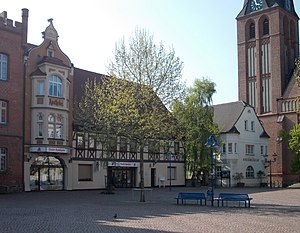Bitterfeld District Museum
 View from the East (2014) |
|
| Data | |
|---|---|
| place | Bitterfeld-Wolfen |
| Art |
Local museum
|
| opening | 1892 |
| operator | |
| management |
Uwe wood
|
| Website | |
| ISIL | DE-MUS-801818 |
The Bitterfeld District Museum is a museum in Bitterfeld-Wolfen . It was founded in 1892 by Emil Obst as a municipal collection of Saxon antiquities, especially those from the town and district of Bitterfeld. The museum has been part of the Anhalt-Bitterfeld district since 2007 .
history
Since 1876, the church director and later museum founder Emil Obst has been collecting written material and sources, but also objects with a local character. More than 15 years later, this collection formed the basis for a municipal museum facility in Bitterfeld . In December 1891, in a letter to the city authorities, Obst asked for “a city collection of Saxon antiquities, especially those from the city and district of Bitterfeld, to be created in order to obtain a conscientious foster home for local history and local history.” The city's magistrate approved this application on 6 January 1892, and the city council confirmed this concern six days later. The first rooms were created in the historic town hall. In doing so, Obst laid the foundation for the library, which has now grown to 10,000 volumes.
As early as 1901, Obst's great zeal for collecting made it necessary to move to the school at the city church. Since then, the collection has been housed in the building built in 1839 as a girls' school between the Protestant church and the town hall. In 1905 the name Stadtmuseum appeared for the first time, and in the early 1960s the house became a district museum. The museum's founder died in 1929.
He was followed by Max Dietze, who previously worked as a businessman in Bitterfeld. The Obstsche estate was bought and taken over into the holdings of the city museum. From 1936, all the rooms in the former school building on Kirchplatz were available to the museum. During this time there was an extensive renovation with an inauguration ceremony in the summer of 1937. Over the years Max Dietze made other acquisitions, including a. Graphics from artists such as Hermann Schiebel and Walter Möbius were adopted.
The Second World War led to an interruption in museum work. Inventories had to be packed and outsourced. After the war, the management passed to Walter Bellmann, during the development of the city museum to the district museum. In 1978 Bellmann resigned as museum director. With Lothar Herbst as the new director, the focus was on public relations.
After the reunification, the house underwent extensive renovation and a new presentation of the collections. At the beginning of 1992, the office of museum director was transferred to Uwe Holz by the Bitterfeld district.
Individual evidence
- ↑ Information on the Bitterfeld District Museum in the German Museum Directory
- ↑ Roswitha Einenkel: Bitterfelder Heimatblätter Volume XV, 1992/100 Years Museum Bitterfeld 1892-1992.
literature
- Roswitha Einenkel: Bitterfelder Heimatblätter Volume XV, 1992/100 Years Museum Bitterfeld 1892–1992.
Web links
Coordinates: 51 ° 37 ′ 26.5 ″ N , 12 ° 19 ′ 45 ″ E